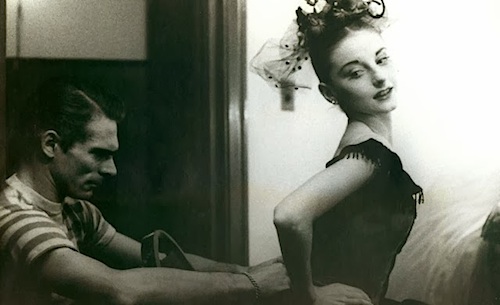By Joe Bendel. She changed the way George Balanchine thought about ballerinas. Essentially, that means she changed ballet. Tanaquil Le Clercq’s life took a unfortunate turn worthy of her tragic characters, but she would have a third act. Nancy Buirski surveys her entire life and art in Afternoon of a Faun: Tanaquil le Clercq, which screens during the 51st New York Film Festival.
A cosmopolitan prodigy, Le Clercq was discovered by Balanchine while she was a difficult student at School of American Ballet. According to her friends, the legendary choreographer first encountering her sulking about the halls after her teacher ejected her from class. Her sophisticated looks certainly caught his eye. Although her height and long limbs were unusual for dancers at that time, Balanchine started tailoring his ballets to her strengths. Soon she was his featured dancer and wife. Then disaster struck.
Ironically, Le Clercq had danced in a special polio-themed March of Dimes fundraiser performance shortly before she was stricken with the disease herself. She would never dance or even walk again. However, she would eventually re-emerge as a teacher at Dance Theatre of Harlem. As for her relationship with Balanchine—it was complicated.
Frankly, it would have been easy for Buirski to cast Balanchine in a villainous light, but Faun is rather remarkable for its evenhanded and forgiving treatment of the dance titan. Taking its lead from Le Clercq’s closest friends, Faun gives him credit for supporting her when she most needed help and eventually re-starting some sort of intimate relationship with his former muse. It was indeed complicated, but maybe not so much for Jerome Robbins, her fair weather ambiguously romantic friend.

Buirski’s sympathetic depiction of Balanchine reflects the humane spirit of film as a whole. While it is eventually destined for American Masters, the elegant and often elegiac dance footage elevates its cinematic-ness. Buirski calls on a relatively small cast of talking heads, but they each clearly knew Le Clercq very well. Perhaps most moving are the remembrances of Jacques d’Amboise, Le Clercq’s partner for many of her defining performances.
Viewers will be surprised at the emotional punch Faun packs. Granted, Buirski follows the tried-and-true documentary filmmaking approach, but she marshals all her elements with considerable style and understanding. The participation of co-producer Ric Burns and project advisor Martin Scorsese should further reassure film snobs. A satisfying viewing experience, Afternoon of a Faun is recommended for dance connoisseurs and anyone with a taste for cultural documentaries. It screens this coming Monday (9/30) at the Walter Reade, as well as the 11th and 13th, as part of the Motion Portraits section of the 2013 NYFF.
LFM GRADE: B+
Posted on September 27th, 2013 at 3:09pm.